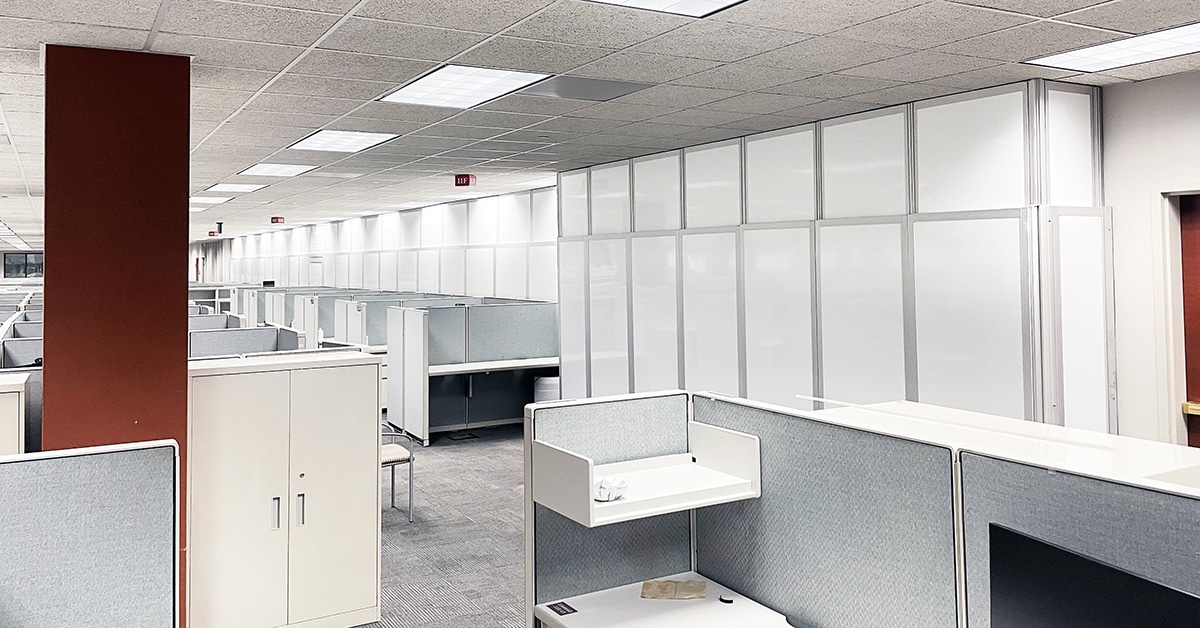
For decades, drywall has been the go-to solution for temporary construction walls. But in an industry that demands flexibility, efficiency, and sustainability, drywall is starting to show its age.
Enter reusable wall systems—the modern answer to the growing challenges of dust, debris, and noise containment. More than just a better alternative, these systems represent a shift in how the construction industry approaches temporary walls: faster, smarter, and more sustainable. The question isn’t whether reusable temporary wall systems are the future, but how soon the industry will fully embrace them.
Why Drywall is No Longer the Default
The True Costs of a ‘Temporary’ Solution
Drywall might appear cost-effective at first glance, but the reality tells a different story. Installation requires a large crew, specialized tools, and significant time. For instance, a 400-linear-foot drywall partition can take a four-person crew several nights to install, while a reusable system requires just two workers for a single night.
In multi-phase projects, drywall’s inefficiencies compound. Tearing down and rebuilding containment for each phase means additional material costs, labor, and disposal fees—none of which are necessary with reusable systems.
The Environmental Toll
The environmental impact of drywall is hard to ignore. A 100-foot section of drywall with a single finished side can generate up to one ton of landfill waste. Add in the emissions from production and transportation, and the sustainability challenges only grow. Reusable temporary wall systems, on the other hand, offer a long-term solution by drastically reducing waste and aligning with green building practices.
Disruptive by Design
Traditional drywall installations are loud, dusty, and disruptive. For sensitive environments like hospitals, airports, and data centers, this isn’t just inconvenient—it can be a serious problem. Patients, travelers, and workers need containment solutions that blend into their surroundings without disrupting daily operations. Reusable walls, designed for seamless installation and minimal mess, meet these needs effortlessly.
The Reusable Revolution: A New Standard for Temporary Walls

Cost-Efficiency Without Compromise
Although reusable systems may have a higher upfront cost, their reusability makes them more economical over time. Many customers report using STARC systems dozens of times, reducing the per-use cost to as little as $10 per linear foot. The ability to reuse walls across multiple projects or phases transforms containment from an expense into a long-term asset.
Speed and Simplicity
Time is money, and reusable wall systems deliver both. With their modular design and straightforward installation process, two workers can install 100 feet of STARC walls in just one hour. Compare this to the labor-intensive process of drywall, and the benefits are clear.
Safety and Compliance for High-Stakes Environments
Reusable systems also excel in settings where safety and compliance are critical. Smooth, non-porous surfaces make them easy to clean, reducing the risk of infection in healthcare environments. Additionally, STARC temporary wall systems exceed rigorous fire safety and infection control standards, including ICRA Class IV/V and ASTM E84 and E119 certifications.
Sustainability at Scale
Choosing reusable temporary walls isn’t just about reducing waste—it’s about rethinking how the industry approaches sustainability. STARC’s products are made in the U.S. using 100% renewable energy and are 95% recyclable by weight. For every 100 feet of wall reused five times, contractors can prevent five tons of landfill waste.

Real-World Examples of Reusable Walls in Action
Hospitals
In healthcare, dust containment must meet strict infection control standards while minimizing stress for patients and staff. As one hospital executive noted, “Reusable containment walls…don’t send the message that there is construction in the facility”. STARC walls ensure ICRA compliance and professionalism without sacrificing appearance.
Airports
Airports demand solutions that minimize disruption for travelers. Dust and noise can’t interfere with operations, and passengers shouldn’t even notice construction is taking place. STARC walls seamlessly blend into these environments, maintaining a calm and orderly atmosphere.

Data Centers
Renovating or expanding data centers comes with unique challenges—protecting highly sensitive equipment from dust, debris, and temperature fluctuations is critical. STARC reusable temporary construction walls provide the perfect solution, creating airtight containment that keeps operations running smoothly.
As Oxford Networks’ Operations Manager John Coray explained, “There have been some unexpected benefits for us in energy efficiency. The servers are functioning much better because of the containment of the cold air and the quick evacuation of the hot air as it rises. It’s really a no-brainer to install a STARC system.”
By safeguarding both the equipment and the work environment, STARC walls offer an unmatched level of protection during renovations in mission-critical settings like data centers.
Why Reusable Temporary Walls Are Here to Stay
The construction industry is moving beyond drywall, and for good reason. Reusable wall systems like STARC’s provide a smarter, more sustainable approach to containment, delivering benefits that drywall simply can’t match. Faster installations, lower costs over time, and reduced environmental impact are just the beginning.
The future of temporary construction walls is reusable. Will your next project keep up?
Schedule a time to speak with a member of our team today. We’re here to help.


